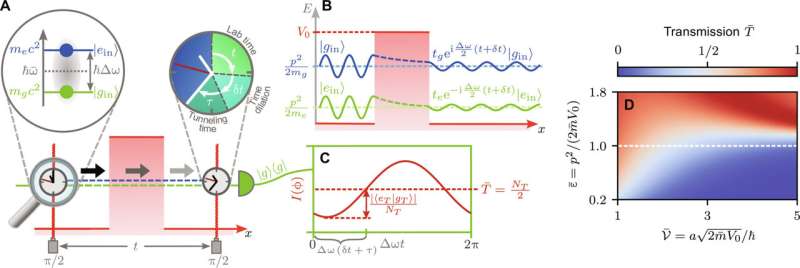This article has been reviewed according to Science X's editorial process and policies. Editors have highlighted the following attributes while ensuring the content's credibility:
fact-checked
peer-reviewed publication
trusted source
proofread
Researchers call for a new measurement of time for tunneling particles

In an amazing phenomenon of quantum physics known as tunneling, particles appear to move faster than the speed of light. However, physicists from Darmstadt believe that the time it takes for particles to tunnel has been measured incorrectly. They propose a new method to stop the speed of quantum particles.
In classical physics, there are hard rules that cannot be circumvented. For example, if a rolling ball does not have enough energy, it will not get over a hill, but will turn around before reaching the top and reverse its direction.
In quantum physics, this principle is not quite so strict: a particle may pass a barrier, even if it does not have enough energy to go over it. It acts as if it is slipping through a tunnel, which is why the phenomenon is also known as "quantum tunneling." What sounds magical has tangible technical applications, for example, in flash memory drives.
In the past, experiments in which particles tunneled faster than light drew some attention. After all, Einstein's theory of relativity prohibits faster-than-light velocities. The question is therefore whether the time required for tunneling was "stopped" correctly in these experiments. Physicists Patrik Schach and Enno Giese from TU Darmstadt follow a new approach to define "time" for a tunneling particle.
They have now proposed a new method of measuring this time. In their experiment, they measure it in a way that they believe is better suited to the quantum nature of tunneling. They have published the design of their experiment in Science Advances.
According to quantum physics, small particles such as atoms or light particles have a dual nature. Depending on the experiment, they behave like particles or like waves.
Quantum tunneling highlights the wave nature of particles. A "wave packet" rolls towards the barrier, comparable to a surge of water. The height of the wave indicates the probability with which the particle would materialize at this location if its position were measured.
If the wave packet hits an energy barrier, part of it is reflected. However, a small portion penetrates the barrier and there is a small probability that the particle will appear on the other side of the barrier.
Previous experiments observed that a light particle has traveled a longer distance after tunneling than one that had a free path. It would therefore have traveled faster than the light. However, the researchers had to define the location of the particle after its passage. They chose the highest point of its wave packet.
"But the particle does not follow a path in the classical sense," objects Enno Giese. It is impossible to say exactly where the particle is at a particular time. This makes it difficult to make statements about the time required to get from A to B.
Schach and Giese, on the other hand, are guided by a quote from Albert Einstein: "Time is what you read off a clock." They suggest using the tunneling particle itself as a clock. A second particle that does not tunnel serves as a reference. By comparing these two natural clocks, it is possible to determine whether time elapses slower, faster or equally fast during quantum tunneling.
The wave nature of particles facilitates this approach. The oscillation of waves is similar to the oscillation of a clock. Specifically, Schach and Giese propose using atoms as clocks. The energy levels of atoms oscillate at certain frequencies. After addressing an atom with a laser pulse, its levels initially oscillate synchronized—the atomic clock is started.
During tunneling, however, the rhythm shifts slightly. A second laser pulse causes the two internal waves of the atom to interfere. Detecting the interference makes it possible to measure how far apart the two waves of the energy levels are, which in turn is a precise measure of the elapsed time.
A second atom, which does not tunnel, serves as a reference to measure the time difference between tunneling and non-tunneling. Calculations by the two physicists suggest that the tunneling particle will show a slightly delayed time. "The clock that is tunneled is slightly older than the other," says Schach. This seems to contradict experiments that attributed superluminal speed to tunneling.
In principle, the test can be carried out with today's technology, says Schach, but it is a major challenge for experimenters. This is because the time difference to be measured is only around 10-26 seconds—an extremely short time. It helps to use clouds of atoms as clocks instead of individual atoms, explains the physicist. It is also possible to amplify the effect, for example by artificially increasing the clock frequencies.
"We are currently discussing this idea with experimental colleagues and are in contact with our project partners," adds Giese. It is quite possible that a team will soon decide to carry out this exciting experiment.
More information: Patrik Schach et al, A unified theory of tunneling times promoted by Ramsey clocks, Science Advances (2024). DOI: 10.1126/sciadv.adl6078
Journal information: Science Advances
Provided by Technische Universitat Darmstadt



















